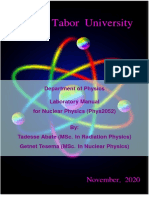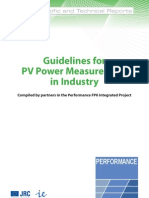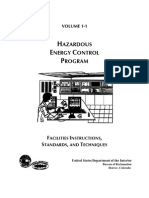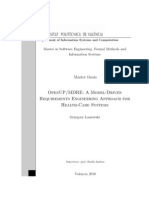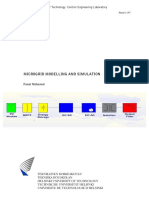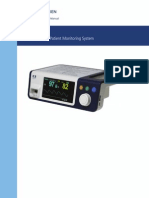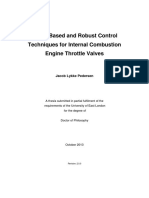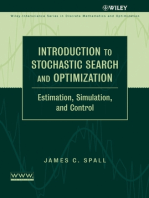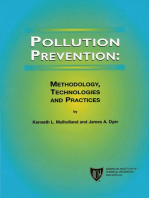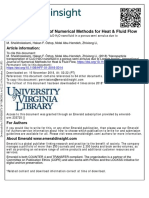Fluid Mechanics and Machinery Laboratory
Uploaded by
Fouad BadriFluid Mechanics and Machinery Laboratory
Uploaded by
Fouad BadriFLUID MECHANICS AND MACHINERY LABORATORY
STUDENTS REFERENCE MANUAL
DEPARTMENT OF MECHANICAL ENGINEERING AWH ENGINEERING COLLEGE KOZHIKODE
FLUID MECHANICS AND MACHINERY LABORATORY GENERAL INSTRUCTIONS TO STUDENTS
The purpose of this laboratory is to reinforce and enhance your understanding of the fundamentals of Fluid mechanics and Hydraulic machines. The experiments here are designed to demonstrate the applications of the basic uid mechanics principles and to provide a more intuitive and physical understanding of the theory. The main objective is to introduce a variety of classical experimental and diagnostic techniques, and the principles behind these techniques. This laboratory exercise also provides practice in making engineering judgments, estimates and assessing the reliability of your measurements, skills which are very important in all engineering disciplines.
Read the lab manual and any background material needed before you come to the lab. You must be prepared for your experiments before coming to the lab. In many cases you may have to go back to your uid mechanics textbooks to review the principles dealt with in the experiment.
Please actively participate in class and dont hesitate to ask questions. Please utilize the teaching assistants fully. To encourage you to be prepared and to read the lab manual before coming to the laboratory, unannounced questions may be asked at any time during the lab.
Never carry out unauthorized experiments. Come to the laboratory prepared. If you are unsure about what to do, please ask the instructor.
Carelessness in personal conduct or in handling equipment may result in serious injury to the individual or the equipment. Do not run near moving machinery. Always be on the alert for strange sounds. Guard against entangling clothes in moving parts of machinery.
Students must follow the proper dress code inside the laboratory. To protect clothing from dirt, wear a lab coat. Long hair should be tied back. Shoes covering the whole foot will have to be worn.
Dont forget to bring calculator, graph sheets and drawing accessories when
you come to lab.
In performing the experiments, please proceed carefully to minimize any water spills, especially on the electric circuits and wire.
Make your workplace clean before leaving the laboratory. Maintain silence, order and discipline inside the lab.
Dont use cell phones inside the laboratory.
Any injury no matter how small, must be reported to the instructor immediately.
Start writing your Laboratory records early, dont wait till the day before the lab records are due. Most experiments require a signicant amount of analysis, which cannot be done properly if you start one or two days before the due date. Start early and give yourself time to get help in case you run into problems, we can not help you if you wait till the last moment.
Wish you a nice experience in this lab!
ii
TABLE OF CONTENTS
GENERAL INSTRUCTIONS TO STUDENTS
1 VERIFICATION OF BERNOULLIS THEOREM
1.1 Objectives . . . . . . . . . . . . . . . . . . . . . . . . . . . . . .
1.2 Equipment required . . . . . . . . . . . . . . . . . . . . . . . .
1.3 Principle . . . . . . . . . . . . . . . . . . . . . . . . . . . . . . .
1.4 Procedure . . . . . . . . . . . . . . . . . . . . . . . . . . . . . .
1.5 Observations and calculations . . . . . . . . . . . . . . . . . . .
1.6 Results and Inference . . . . . . . . . . . . . . . . . . . . . . . .
2 CALIBRATION OF OBSTRUCTION FLOW METERS
2.1 Objectives . . . . . . . . . . . . . . . . . . . . . . . . . . . . . .
2.2 Equipment required . . . . . . . . . . . . . . . . . . . . . . . .
2.3 Principle . . . . . . . . . . . . . . . . . . . . . . . . . . . . . . .
2.4 Procedure . . . . . . . . . . . . . . . . . . . . . . . . . . . . . .
2.5 Observations and calculations . . . . . . . . . . . . . . . . . . .
2.6 Results and Inference . . . . . . . . . . . . . . . . . . . . . . . .
3 CALIBRATION OF EXTERNAL FLOW MEASURING NOTCHES
3.1 Objectives . . . . . . . . . . . . . . . . . . . . . . . . . . . . . .
3.2 Equipment required . . . . . . . . . . . . . . . . . . . . . . . .
3.3 Principle . . . . . . . . . . . . . . . . . . . . . . . . . . . . . . .
3.4 Procedure . . . . . . . . . . . . . . . . . . . . . . . . . . . . . .
3.5 Observations and calculations . . . . . . . . . . . . . . . . . . .
3.6 Results and Inference . . . . . . . . . . . . . . . . . . . . . . . .
4 FLOW COEFFICIENTS OF MOUTHPIECE AND ORIFICE
4.1 Objectives . . . . . . . . . . . . . . . . . . . . . . . . . . . . . .
4.2 Equipment required . . . . . . . . . . . . . . . . . . . . . . . .
iii i 1 1 1 1 3 3 4 5 5 5 5
5 9 9 10 11 11 11 11 14 14 15 16 16 16
4.3 Principle . . . . . . . . . . . . . . . . . . . . . . . . . . . . . . .
4.4 Procedure . . . . . . . . . . . . . . . . . . . . . . . . . . . . . .
4.5 Observations and calculations . . . . . . . . . . . . . . . . . . .
4.6 Results and Inference . . . . . . . . . . . . . . . . . . . . . . . .
5 FRICTIONAL LOSSES IN PIPE FLOW
5.1 Objectives . . . . . . . . . . . . . . . . . . . . . . . . . . . . . .
5.2 Equipment required . . . . . . . . . . . . . . . . . . . . . . . .
5.3 Principle . . . . . . . . . . . . . . . . . . . . . . . . . . . . . . .
5.4 Procedure . . . . . . . . . . . . . . . . . . . . . . . . . . . . . .
5.5 Observations and Calculations . . . . . . . . . . . . . . . . . . .
5.6 Results and Inference . . . . . . . . . . . . . . . . . . . . . . . .
6 CONSTANT SPEED CHARACTERISTICS OF SINGLE STAGE CENTRIFU-
GAL PUMP
6.1 Objectives . . . . . . . . . . . . . . . . . . . . . . . . . . . . . .
6.2 Equipment required . . . . . . . . . . . . . . . . . . . . . . . .
6.3 Principle . . . . . . . . . . . . . . . . . . . . . . . . . . . . . . .
6.4 Procedure . . . . . . . . . . . . . . . . . . . . . . . . . . . . . .
6.5 Observations and Calculations . . . . . . . . . . . . . . . . . . .
6.6 Results and Inference . . . . . . . . . . . . . . . . . . . . . . . .
7 VARIABLE SPEED CHARACTERISTICS OF SINGLE STAGE CENTRIFU-
GAL PUMP
7.1 Objectives . . . . . . . . . . . . . . . . . . . . . . . . . . . . . .
7.2 Equipment required . . . . . . . . . . . . . . . . . . . . . . . .
7.3 Principle . . . . . . . . . . . . . . . . . . . . . . . . . . . . . . .
7.4 Procedure . . . . . . . . . . . . . . . . . . . . . . . . . . . . . .
7.5 Observations and Calculations . . . . . . . . . . . . . . . . . . .
7.6 Results and Inference . . . . . . . . . . . . . . . . . . . . . . . .
8 PERFORMANCE OF RECIPROCATING PUMP
8.1 Objectives . . . . . . . . . . . . . . . . . . . . . . . . . . . . . .
8.2 Equipment required . . . . . . . . . . . . . . . . . . . . . . . .
iv
25
30 16 19 20 20 21 21 21 21 23 23 24 25 25 25 27 28 29 30 30 30 32 33 33 34 34 34
8.3 Principle . . . . . . . . . . . . . . . . . . . . . . . . . . . . . . .
8.4 Procedure . . . . . . . . . . . . . . . . . . . . . . . . . . . . . .
8.5 Observations and Calculations . . . . . . . . . . . . . . . . . . .
8.6 Results and Inference . . . . . . . . . . . . . . . . . . . . . . . .
9 PERFORMANCE OF GEAR PUMP
9.1 Objectives . . . . . . . . . . . . . . . . . . . . . . . . . . . . . .
9.2 Equipment required . . . . . . . . . . . . . . . . . . . . . . . .
9.3 Principle . . . . . . . . . . . . . . . . . . . . . . . . . . . . . . .
9.4 Procedure . . . . . . . . . . . . . . . . . . . . . . . . . . . . . .
9.5 Observations and Calculations . . . . . . . . . . . . . . . . . . .
9.6 Results and Inference . . . . . . . . . . . . . . . . . . . . . . . .
10 LOAD TEST ON PELTON TURBINE
10.1 Objectives . . . . . . . . . . . . . . . . . . . . . . . . . . . . . .
10.2 Equipment required . . . . . . . . . . . . . . . . . . . . . . . .
10.3 Principle . . . . . . . . . . . . . . . . . . . . . . . . . . . . . . .
10.4 Procedure . . . . . . . . . . . . . . . . . . . . . . . . . . . . . .
10.5 Observations and Calculations . . . . . . . . . . . . . . . . . . .
10.6 Results and Inference . . . . . . . . . . . . . . . . . . . . . . . .
v 34 36 37 37 38 38 38 38 40 40 41 42 42 42 42 44 45 45
EXPERIMENT 1
VERIFICATION OF BERNOULLIS THEOREM
1.1
Objectives
The objective is to validate Bernoullis assumptions and theorem by exper-
imentally proving that the sum of the terms in the Bernoulli equation along a
streamline always remains a constant.
1.2
Equipment required
Apparatus for the verication of Bernoullis theorem and measuring tank with
stop watch setup for measuring the actual ow rate.
1.3
Principle
The Bernoulli theorem is an approximate relation between pressure, velocity,
and elevation, and is valid in regions of steady, incompressible ow where net
frictional forces are negligible. Despite its simplicity, it has been proven to be a
very powerful tool for uid mechanics. The key approximation in the derivation
of Bernoullis equation is that viscous effects are negligibly small compared to
inertial, gravitational, and pressure effects. We can write the theorem as,
Pressure head (
V2 ) + Velocity head ( ) + Elevation (Z) = a constant (1.1) 2g
Figure 1.1: Pressure head increases with decrease in velocity head.
g P
where,
P = the pressure.(N/m2)
= density of the uid, kg/m3 V = velocity of ow, (m/s) g = acceleration due to gravity, m/s2
Z = elevation from datum line, (m)
Note that all the individual terms in the summation have the same dimension,
m of uid.
Figure 1.2: Apparatus.
The discharge through the test section can be determined using the collecting
tank and stopwatch setup.
Actual discharge, Qac =
aH t
(m3/s)
(1.2)
where,
a = area of the collecting tank.(m2)
H = height difference of the water column in the piezometer, (m)
t = time taken to rise H meters, (sec)
The velocity of ow at the cross section A1 is, V1 =
Then the velocity
head , Hv1 = 2g . Assuming that the pipe line has negligible frictional losses in the ow and the elevation is constant everywhere, Bernoulliss equation for the
horizontal pipe at cross section A1 can be veried as, Pressure head (HP1) + Velocity head (Hv1) = Const:
1.4
Procedure
1. Observe the dimensions of the convergent divergent duct of the apparatus. Note it down. Measure the collecting tank cross sectional area.
2. Open the inlet valve to the supply tank and allow water to ll up to a high level.
3. Open the outlet valve and regulate both the inlet and outlet valves so that the head in the supply tank remains constant.
4. Note the time to collect water for a specic rise in the collecting tank and thus nd the discharge through the duct.
5. Note down the all the piezometer readings at different locations A1, A2, ..up-to A11.
6. Repeat the experiment for a medium and low head levels in the supply tank.
7. Plot the curves showing the variation of Hp, Hv and Ht with position and tabulate the readings.
Observations and calculations Collecting tank size = cm2
3 Qac A1 . 2 V1 1.5
1.6
Results and Inference
The Bernoullis theorem is veried and the variation in total head is due to
frictional losses.
EXPERIMENT 2
CALIBRATION OF OBSTRUCTION FLOW METERS
2.1
Objectives
The aim of this experiment is to 1. Calibrate the given obstruction owme-
ters, 2. Plot the characteristics and to nd their coefcient of discharge for
different rates of ow and 3. Obtain an appreciation of how these meters work
and of the theory behind the apparatus.
2.2
Equipment required
Supply pipe connected with the ow meters, a differential manometer to
measure the pressure difference across the the obstruction and a collecting tank
with stop watch to measure the actual rate of ow.
2.3
Principle
The obstruction ow meter is a device used to measure the discharge of an
internal ow. In these meters ow rate is calculated by measuring the pressure
drop over an obstruction which is inserted in to path of the ow. There are many
classications according to the type obstruction used. The most commonly used
categories are Venturi meter, orice meter and nozzle meter.
Venturi meters are generally made from castings machined to close toler-
ances to duplicate the performance of the standard design, so they are heavy,
Figure 2.1: Venturi meter
bulky, and expensive. Inside the venturi meter the uid is accelerated through a converging cone of angle 15 20o. The pressure difference between the up-
stream side of the cone and the throat is measured by using a differential manome-
ter and it provides a measure for the discharge. The conical diffuser section downstream from the throat with a lower angle 8 12o gives excellent pressure
recovery and so overall head loss is low compared to other obstruction ow me-
ters. Venturi meters are self-cleaning because of their smooth internal shape.
Figure 2.2: Orice meter
The orice meter consists of a at orice plate with a circular hole drilled
in it. The construction is very simple and so cost is low compared to other
obstruction meters. There is a pressure tap upstream from the orice plate and
another just downstream. Reduction of cross-section of the owing stream in
passing through orice increases the velocity head at the expense of pressure
head. This reduction of pressure between taps is measured using a differential
manometer and it gives a measure of the discharge. The pressure recovery is
poor compared to the Venturi meter.
The expression for discharge through any obstruction ow meter can be the-
oretically obtained using the continuity and Bernoullis equations together. The
Bernoullis equation is dened for steady, incompressible and inviscid regions of
ow. Since the Bernoullis equation is a simplied form of energy equation, the
assumptions used for simplication must be satised when using it for practical
cases. The continuity equation for discharge (Q) through a pipe with the above
assumptions is,
Qth = A V , where A= ow area (m2) and V=ow velocity (m/s)
Let the pipe area be A1 and the throat area of the meter be A2. Then we can write the continuity equation as,
Qth = A1V1 = A2V2 = a const.
which implies,V1 =
Now the Bernoullis equation is stated as,
A2 A1
V2
P1 V1 wg 2g
+ Z1 =
P2 V2 wg 2g
+ Z2
Since Z1 = Z2, we can substitute V1 from the continuity equation and rearrange to get,
V2 =
2 P
w 1
where,P = P1 P2 is the pressure drop between the inlet and the throat of the meter in N/m2. Since we use Mercury differential manometers to measure
P we can use the relation P = (Hg w)gh for conversion, where h is the height of mercury column.
So the theoretical expression for discharge becomes,
Qth = A1A2
Hg w 1 (A2 A2)
gh
(2.2)
where,
g = acceleration due to gravity (m/s2) Hg = density of the manometer uid, (kg/m3) W = density of the owing uid, (kg/m3)
7 (2.1) + + 2 A2 A1 2 1 2
Actual discharge through the device can be determined using the collecting
tank and stopwatch setup.
Actual discharge, Qac =
aH t
(m3/s)
(2.3)
where,
a = area of the collecting tank, (m2)
H= height difference of the water column in the piezometer, (m)
t = time taken to rise H meters, (sec)
The coefcient of discharge CD, is dened as the ratio of actual discharge obtained experimentally to the theoretical discharge obtained using the expression
we derived. i.e.,
CD =
Qac Qth
(2.4)
The next step is the calibration of the meters. Calibration process is the vali-
dation of specic measurement techniques and equipment. It is the comparison
between measurements of known magnitude made with one device and another
measurement made in as similar way as possible with a second device. In order
to use any device for measurement it is necessary to empirically calibrate them.
That is, here in the case of ow meter, pass a known discharge through the meter
and note the reading in order to provide a standard for measuring other quanti-
ties in a different location. Provided the standard mechanics of construction are
followed no further calibration is required for a similar second device with same
geometry.
In general, the calibration equation for ow meters is stated as,
Qac = K hn.
(2.5)
where K and n are constants depending on the geometry of the obstruction
ow meter. Taking logarithm on both sides we get,
log Qac = log k + n log h
(2.6)
which is the equation of a straight line, where log k is the y intercept and n is its
slope. The experimental values obtained are used to nd the values of k and n.
The graph log Qac Vs. log h is to be plotted to nd them.
2.4
Procedure
1. Check the experimental setup for leaks. Measure the dimensions of collecting tank. Note down the ow meter specications.
2. Open the inlet valve fully and allow the water to ll fully in the ow meter.
3. Make sure the height of Mercury column in both limbs are same if there is no discharge through the meter.
4. Slightly open the outlet valve of the ow meter and observe the manometer limbs.
5. Adjust it to get a steady pressure difference between the limbs of the manometer. Note down the corresponding Mercury levels.
6. Measure the time t to collect H height of water in the collecting tank.
7. Repeat the above procedure for different ow rates by changing the outlet valve opening. Tabulate the readings.
8. Change the pressure tapping valves and repeat the same procedure for second meter.
9. Close the inlet to the apparatus after taking the necessary readings.
10. Complete the tabulation and nd the average value of CD in both cases.
11. Draw the necessary graphs and calibrate the meters.
Observations and calculations
Diameter of the throat = m
Diameter of the pipe
Collecting tank area
= m = m2
You might also like
- Safety Distance: Rules For Pressure Testing Lloyds Register (96-02)67% (6)Safety Distance: Rules For Pressure Testing Lloyds Register (96-02)2 pages
- CE600E - V2.2-Duplex Continuous RectificationNo ratings yetCE600E - V2.2-Duplex Continuous Rectification132 pages
- Department of Physics Laboratory Manual For Nuclear Physics (Phys2052)No ratings yetDepartment of Physics Laboratory Manual For Nuclear Physics (Phys2052)132 pages
- A Course Entitled "Particle Counting To ISO 14644 Parts 1& 2"No ratings yetA Course Entitled "Particle Counting To ISO 14644 Parts 1& 2"5 pages
- Basic Electronics:: Carnegie Mellon Lab ManualNo ratings yetBasic Electronics:: Carnegie Mellon Lab Manual145 pages
- Rankine Cycles Modeling and Control. Ylva TeleNo ratings yetRankine Cycles Modeling and Control. Ylva Tele55 pages
- Third National Health and Nutrition Examination Survey IiiNo ratings yetThird National Health and Nutrition Examination Survey Iii82 pages
- SOP Pipettes AESOP13640-08 052013 en Online PDFNo ratings yetSOP Pipettes AESOP13640-08 052013 en Online PDF0 pages
- 08 Estandar Internacional de Laboratorios 2021No ratings yet08 Estandar Internacional de Laboratorios 2021160 pages
- EE 213 Electrical Machines Lab Manual - 2018No ratings yetEE 213 Electrical Machines Lab Manual - 201858 pages
- PurdueThesis Template for Purdue University Theses Dissertations Etc V2-Compressed (1)No ratings yetPurdueThesis Template for Purdue University Theses Dissertations Etc V2-Compressed (1)222 pages
- MPD 600 TransformerTest User Manual ENUNo ratings yetMPD 600 TransformerTest User Manual ENU41 pages
- A7213 Operator's Manual (En) Nellcor LIBRA100% (2)A7213 Operator's Manual (En) Nellcor LIBRA120 pages
- AME341b 2010 Lecture& Lab Notes JerryNo ratings yetAME341b 2010 Lecture& Lab Notes Jerry114 pages
- Model Based and Robust Control Techniques For Internal Combustion Engine Throttle ValvesNo ratings yetModel Based and Robust Control Techniques For Internal Combustion Engine Throttle Valves360 pages
- Practical Book On Engineeirng ChemistryNo ratings yetPractical Book On Engineeirng Chemistry141 pages
- WL377e - Natural Convection and Radiation - V0.1No ratings yetWL377e - Natural Convection and Radiation - V0.149 pages
- TOM_Lab-_Manuals_1722324360147760368266a89588d1438.3_eNo ratings yetTOM_Lab-_Manuals_1722324360147760368266a89588d1438.3_e42 pages
- Uncertainty in Industrial Practice: A Guide to Quantitative Uncertainty ManagementFrom EverandUncertainty in Industrial Practice: A Guide to Quantitative Uncertainty ManagementNo ratings yet
- Quality and Performance Measurement in National Sport-Governing BodiesFrom EverandQuality and Performance Measurement in National Sport-Governing BodiesNo ratings yet
- Introduction to Stochastic Search and Optimization: Estimation, Simulation, and ControlFrom EverandIntroduction to Stochastic Search and Optimization: Estimation, Simulation, and Control4/5 (2)
- Pollution Prevention: Methodology, Technologies and PracticesFrom EverandPollution Prevention: Methodology, Technologies and PracticesNo ratings yet
- Biennial Report on Operations Evaluation: Assessing the Monitoring and Evaluation Systems of IFC and MIGAFrom EverandBiennial Report on Operations Evaluation: Assessing the Monitoring and Evaluation Systems of IFC and MIGANo ratings yet
- Calculation of Pigging Effectiveness For Petroleum (Product) PipelinesNo ratings yetCalculation of Pigging Effectiveness For Petroleum (Product) Pipelines7 pages
- Fluid Mechanics 2024 (ST - Xavier's) (2024)No ratings yetFluid Mechanics 2024 (ST - Xavier's) (2024)71 pages
- Pt. Wahana Chemindo Jaya: Company ProfileNo ratings yetPt. Wahana Chemindo Jaya: Company Profile10 pages
- Mechanical Interview Questions and Answers Fluid Mechanics50% (2)Mechanical Interview Questions and Answers Fluid Mechanics2 pages
- International Journal of Numerical Methods For Heat & Fluid FlowNo ratings yetInternational Journal of Numerical Methods For Heat & Fluid Flow16 pages
- Investigating Three-Dimensional and Rotational Effects On Wind Turbine Blades by Means of A Quasi-3D Navier-Stokes Solver - ChaviaropoulosNo ratings yetInvestigating Three-Dimensional and Rotational Effects On Wind Turbine Blades by Means of A Quasi-3D Navier-Stokes Solver - Chaviaropoulos7 pages
- Convective Heat Transfer in Rotating Radial Circular PipesNo ratings yetConvective Heat Transfer in Rotating Radial Circular Pipes14 pages
- Effects of Rear Spoilers On Ground Vehicle Aerodynamic DragNo ratings yetEffects of Rear Spoilers On Ground Vehicle Aerodynamic Drag16 pages
- Problem - 5-1 Material Balance Water Influx - Jun07No ratings yetProblem - 5-1 Material Balance Water Influx - Jun0711 pages
- Safety Distance: Rules For Pressure Testing Lloyds Register (96-02)Safety Distance: Rules For Pressure Testing Lloyds Register (96-02)
- Department of Physics Laboratory Manual For Nuclear Physics (Phys2052)Department of Physics Laboratory Manual For Nuclear Physics (Phys2052)
- A Course Entitled "Particle Counting To ISO 14644 Parts 1& 2"A Course Entitled "Particle Counting To ISO 14644 Parts 1& 2"
- Third National Health and Nutrition Examination Survey IiiThird National Health and Nutrition Examination Survey Iii
- PurdueThesis Template for Purdue University Theses Dissertations Etc V2-Compressed (1)PurdueThesis Template for Purdue University Theses Dissertations Etc V2-Compressed (1)
- Model Based and Robust Control Techniques For Internal Combustion Engine Throttle ValvesModel Based and Robust Control Techniques For Internal Combustion Engine Throttle Valves
- TOM_Lab-_Manuals_1722324360147760368266a89588d1438.3_eTOM_Lab-_Manuals_1722324360147760368266a89588d1438.3_e
- Uncertainty in Industrial Practice: A Guide to Quantitative Uncertainty ManagementFrom EverandUncertainty in Industrial Practice: A Guide to Quantitative Uncertainty Management
- Quality and Performance Measurement in National Sport-Governing BodiesFrom EverandQuality and Performance Measurement in National Sport-Governing Bodies
- Introduction to Stochastic Search and Optimization: Estimation, Simulation, and ControlFrom EverandIntroduction to Stochastic Search and Optimization: Estimation, Simulation, and Control
- Pollution Prevention: Methodology, Technologies and PracticesFrom EverandPollution Prevention: Methodology, Technologies and Practices
- Biennial Report on Operations Evaluation: Assessing the Monitoring and Evaluation Systems of IFC and MIGAFrom EverandBiennial Report on Operations Evaluation: Assessing the Monitoring and Evaluation Systems of IFC and MIGA
- Calculation of Pigging Effectiveness For Petroleum (Product) PipelinesCalculation of Pigging Effectiveness For Petroleum (Product) Pipelines
- Mechanical Interview Questions and Answers Fluid MechanicsMechanical Interview Questions and Answers Fluid Mechanics
- International Journal of Numerical Methods For Heat & Fluid FlowInternational Journal of Numerical Methods For Heat & Fluid Flow
- Investigating Three-Dimensional and Rotational Effects On Wind Turbine Blades by Means of A Quasi-3D Navier-Stokes Solver - ChaviaropoulosInvestigating Three-Dimensional and Rotational Effects On Wind Turbine Blades by Means of A Quasi-3D Navier-Stokes Solver - Chaviaropoulos
- Convective Heat Transfer in Rotating Radial Circular PipesConvective Heat Transfer in Rotating Radial Circular Pipes
- Effects of Rear Spoilers On Ground Vehicle Aerodynamic DragEffects of Rear Spoilers On Ground Vehicle Aerodynamic Drag
- Problem - 5-1 Material Balance Water Influx - Jun07Problem - 5-1 Material Balance Water Influx - Jun07








